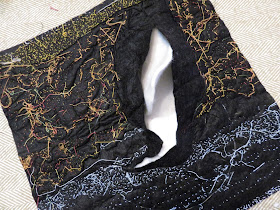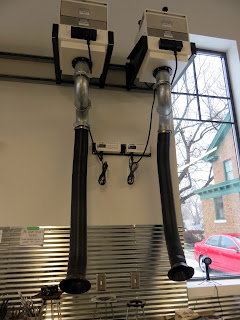My Springfield Art Association residency proposal called for a "creative clothesline" made from vintage and found textiles that would draw attention to the benefits of line drying, the need for household energy conservation, and the beauty of doing things BY HAND! If you've been following my blog posts, I left off after a weekend of tracing and cutting my hand and forearm outlines from fabric to which I'd already added a heat-activated adhesive (Wonder Under). It took two days. I estimated four hand prints per pillowcase, two on each side. I have sixty pillowcases. They were legally salvaged from the former South Carolina State Mental Hospital.
(Above: A stack of thirty-two pillowcases and several household linens onto which I fused the fabric hand prints.)
I wasn't sure exactly how many hand prints I had, but it took the better part of a day to iron them onto thirty-two pillowcases. I also added handkerchiefs, embroidered doilies, finger tip towels, and other items from my stash of vintage material. I was finally ready to sew!

(Above: Zigzag stitching around the fused hand prints.)
I used the stop watch on my smart phone to time how long it took to zigzag stitch around a hand print. After stitching ten, I learned my average time was four minutes and one second. With an average of four hand prints per pillowcase, that works out to a hair over sixteen minutes of stitching times thirty-two ... or eight-and-a-half hours. Of course, this doesn't include the time to get the hand print under the machine, deal with the thread ends, and get the next pillowcase ready to go. It also doesn't include the time to stitch around the added doilies, handkerchiefs, etc. or eat or go to the bathroom or sight-see in Springfield. Also, I promised myself that I would NOT work on The Clothesline in the evenings. That's been a time to hand-stitch on 12" x 12" mini art quilts.
(Above: Chairs that helped organize my stitching!)
It took two-and-a-half days to complete the stitching on these thirty-two pillowcases and five vintage pieces. To speed up the process, I knew I couldn't stitch the pillowcases individually. I would spend way too much time switching out bobbin and top thread. So, I used three chairs to keep track of what I was doing. How did this work? Well when stitching with blue thread, I worked my way through the original stack ... stitching around the hand prints needing blue thread ... and putting that pillowcase onto the next chair, creating a stack of "blue finished" pillowcases. Then, I switched to pink thread and worked through the stack ... putting each "pink finished" pillowcase back on the first chair. Back and forth the stack went. As a pillowcase got totally finished, it went on the third chair ... until they were all there ... done!
(Above: Ironing the finished pillowcases.)
This morning I ironed the finished stack. I took photos of several of the pieces.
For some reason, I tended to snap images of the single hand prints on a found textile.
As I ironed, I tallied the hand prints. My estimate was off a little (probably because of the several "single" hand print sides!). There are now one-hundred and seventeen hand prints in the collection.
I think I really like the single hand print sides because I've never really had a good use for handkerchiefs, especially not the sort that were "made in China". They've always looked sort of "cheap" to me even though I am well aware that many were given as special Mother's Day, anniversary, and Christmas gifts. They have stories to tell despite the dime store appearance ...
... they really add to these pillowcases!
After ironing all the pillowcases, I decided to hang them on the residency porch. I'm on the second floor; so they are safe.
This represents a solid week of work with a minimum of eight hours a day on the project. Yet, the results only fill two lengths of the porch's width. Each pillowcase is only seventeen inches on the short side. Once all sixty are finished, I'll have eighty-five feet of clothesline (or just twenty-five yards).
(Above: A ball of yellow cording brought from home for the actually clothesline and a container of thread donated to me by a friend.)
I'm really pleased with the progress of this project and especially honored to have this art residency during which I can bring it into existence. Without this dedicated time to focus on the work, The Clothesline probably wouldn't happen. At home, I can't spend eight hours a day for several weeks on any one project. This is what makes an art residency truly "a gift of time." Below are more photos from the porch! Now ... back to work! I've got another twenty-eight pillowcases and more vintage textiles needing hand prints that I haven't even cut yet!


















































